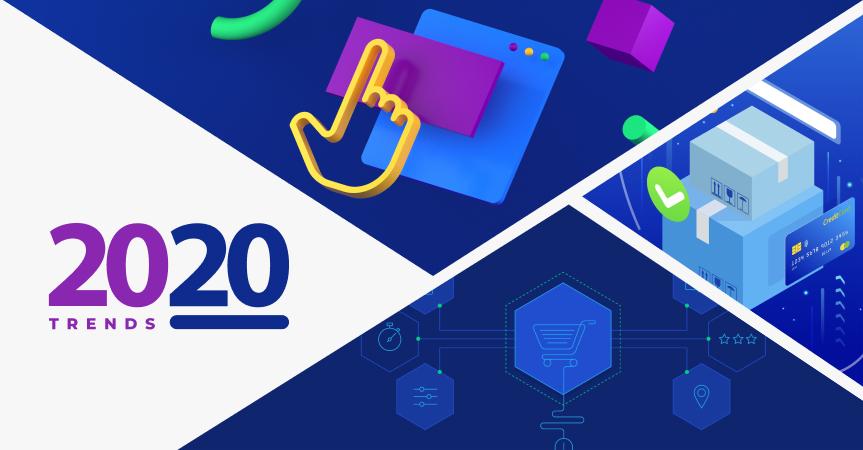15 Ecommerce Trends Of 2020: Adapt Your Business To The Upcoming Changes

One of the major concerns of any entrepreneur is predicting what’s coming. That is why one should keep an eye on how markets change. Learn about the eСommerce trends of 2020 to stay up to date!
The world keeps changing, and so does the business environment. eCommerce was once an exotic innovation, but nowadays it’s a huge economy sector which influences corporations all over the globe.
Moreover, eCommerce allows even those with limited budget to start their own business and flourish. However, the market waits for no one, and if you don’t keep up with the changes, you might find yourself left behind.
To avoid it, learn about the upcoming eCommerce trends of 2020!
1. Mobile sales will keep rising in eCommerce

Anyone doing business online knows how important it is to make your eCommerce website mobile friendly. The thing is, a lot of people actually visit pages and choose products on smartphones and tablets. But there’s more to it, as it isn’t just mobile traffic that rises – sales do too!
As mobile payments are becoming more secure, people now feel safe when making purchases on their smartphones and tablets. The process is getting easier, and more devices support new payment methods. As a result, nowadays consumers trust this technology much more than a couple of years ago.
According to Statista, the mobile share of all eCommerce sales exceeded 50% in 2016. It is expected to exceed 70% in 2020 and reach 72.9% in 2021. Surely, you’re making a smart long-term eCommerce business decision when you optimize for mobile!
2. Homepages are giving way to eCommerce product pages

Website homepages are generally considered to be the storefronts of eCommerce businesses. Therefore, the business owners need to optimize them properly to make sure the website visitors feel comfortable. However, nowadays entrepreneurs tend to prioritize other pages.
When Internet users want to find something online (be it a product or information), they usually land on internal pages with product descriptions, useful articles or videos, etc. On the other hand, a lot of people get to the homepage of your site by searching the brand’s name in the search field or typing its exact address.
In other words, homepages usually attract the people who already know about your eCommerce website, while other pages are mostly visited by new audience.
Thus, these pages deserve more attention in terms of optimization because this is probably where new visitors interact with your eCommerce site for the first time.
So, one must work harder on those pages designed to convert visitors into customers to make sure they provide the content people are looking for, are easy to navigate, answer all potential questions and provide alternative options if it’s product pages.
3. Video product descriptions

Speaking of product pages, let’s consider this. When buying something, we want to know as much as possible about the product. However, online shopping doesn’t always allow you to thoroughly examine the item before you purchase. That’s why product descriptions are important, but texts tend to bore site visitors.
And that’s another one of the upcoming eCommerce marketing trends of 2020. Today consumers (especially the young) prefer watching video descriptions rather than reading them. According to YouGov’s survey, about 50% of consumers want to watch a video when buying personal electronics, household appliances, software and tools. 27% of respondents feel the same when buying personal care products, while 35% want to watch a video when buying clothes and make-up.
Consequently, in 2020, one must consider using product video descriptions to stimulate purchases in eCommerce.
4. Merging online and offline

At first, eCommerce businesses emerged as a kind of opposition to the traditional retail. Soon after that, offline retailers realized the potential of online deals, and many of them started offering their goods on the web.
But the process goes the other direction too. Businesses that used to work only online are now taking a step into the real world. For example, Amazon is opening physical stores with the same products.
In other words, it seems that eCommerce businesses aim at offering consumers both online and offline shopping options at the same time.
5. User generated content

Although many social media platforms allow entrepreneurs to advertise their brands, users often perceive such ads as boring, not to mention the level of competition. In the meantime, people starve for authentic content, which many brands fail to create.
Influencer marketing was, and still is, a good attempt to offer consumers something original and convincing, but consumers find user generated content 9.8 times more impactful.
The best thing about UGC is that it is created not by a company or a hired influencer, but by regular consumers. People tend to trust the opinion of those not working for the brand.
Therefore, convincing your customers to write reviews, make videos, take pictures and mention your brand will become one of the eCommerce trends in 2020.
6. Interactive visualization in eCommerce

Although online shopping is on the rise, many consumers still want to touch a product before buying it. The usual 2d pictures don’t always prompt a quicker purchasing decision. As mentioned above, using video product description is one way to solve this problem. However, there are even more technologically advanced alternatives.
Some online (and offline) retailers are already using virtual and augmented reality. Imagine you want to buy a wardrobe, but it’s hard to tell whether it’ll suit your living room. But what if you could just see how the wardrobe looks inside your room with your smartphone?
According to Retail Perceptions, 71% of consumers would buy more stuff if the retailer offered them augmented reality. Therefore, those who find a way to do this will definitely have an advantage over their competitors.
7. Voice search

As smartphones are becoming an integral feature of our lives, they will continue to play a huge role in search engine optimization and eCommerce promotion. Moreover, with new technologies emerging, marketers have no choice but to adapt.
When Apple introduced Siri, it seemed like a curious but useless toy. However, the accuracy of voice recognition today equals to 95%.
In 2016, 1 of 5 mobile queries was made via voice search. By 2020, this figure will rise to 50%. And it’s not just mobile phones because there are technologies like Google Home or Amazon Echo that allow you to search things online by giving voice commands. It means that in a few years, even PC users will prefer voice search over typing.
As a result, entrepreneurs will have to optimize their eCommerce sites for long-tail keywords (typical for voiced search), offer new content based on what questions came from this source, etc.
8. Selling through social media

Almost any eCommerce entrepreneur uses social media marketing to some degree. However, social media aren’t just useful tools for increasing customer engagement. They are turning into retail platforms by allowing users to buy products directly without having to go to the retailer’s site.
From retailers’ point of view, social selling a huge step that eliminates a lot of obstacles between customers and sales. Today a person can purchase something he or she saw in their feed by simply clicking on the ‘buy’ button.
9. Chatbots and private messages

A lot of customers want to ask some questions before buying something. Often, these questions are simple enough, and companies use chatbots and artificial intelligence. Moreover, a lot of buyers actually expect that their preferred online store offers customers this opportunity.
- Chatbots can work 24/7.
- They provide quick answers to frequently asked questions.
- Chatbots can tell customers about payment methods, delivery guarantee, working hours, etc.
- Can collect feedback from clients.
With AI systems getting more complicated, this is definitely going to be one of the eCommerce trends in 2020.
10. Automation

The days when you had to walk to a shop to ask if they have what you want are long gone. Today you can check a store’s inventory online, but there’s still a lot to do in this field.
A successful eCommerce business requires automating a variety of things including inventory management, processing orders, scheduling delivery and sales, etc.
AliDropship plugin is a good example of this ecommerce trend as it allows you to automate most of your dropshipping store’s work.
Automation is also very important for personalization. If you teach the system to recognize certain customers, you can send them personalized welcomes and offers, thus, earning their trust and loyalty.
11. Multichannel engagement

Do you know anyone who has a Facebook account? I mean ONLY a Facebook account. Most people also have accounts on multiple channels: Instagram, Snapchat, LinkedIn, etc. Same goes for shopping because 85% of people aged 18-34 buy online from at least two different platforms.
Therefore, using just one engagement channel is no longer an option for business, and going multi channel gets vital. To get your share of customers, you have to use a number of tools, while your eCommerce business must be available on a variety of social media.
12. Subscription-based models

Another eCommerce trend to rise in 2020 is the use of subscription-based business models.
Instead of making big single purchases (like cars or property), young people today prefer spending smaller shares of money on cheaper things. In addition, millennials do not just buy things: they want a personal experience. Therefore, they feel excited about monthly services and products which are distributed via subscription-based models.
Besides, a lot of people find it easier to subscribe once and forget about having to repeat purchases each month or weekend, thus, delegating this task to business.
However, to keep up with customers’ expectations, companies using subscription-based models have to generate new ideas and offers regularly or they risk losing their clients.
13. Personalization in eCommerce

Instead of standard products, many eCommerce businesses aim to offer customizable and personalized goods. So, one can have a T-shirt or laptop with a personalized design, color, print, etc.
Although such alternatives to standard offers are usually more expensive, people are ready to pay for the opportunity to have something they can call “theirs”, something unique. Besides, with modern tools and technologies, designing your own mug is a piece of cake. All you need to do is upload a picture and make a couple of clicks.
At the same time, personalized offers are a great way to build customer loyalty. A person who has spent 15 minutes making a perfect T-shirt is more likely to make this purchase. And if you’ve done well, this client will most likely come for a pleasant shopping experience again. So, make sure to make a good use of this and other eCommerce trends in 2020.
14. Topic clusters

Almost any business in eCommerce uses content marketing to promote its brand and products.
In simple terms, in order to attract traffic, you have to create long articles (1000+ words) on a given subject. Google algorithms like such content and tend to place it on the top. At the same time, such content educates or entertains your potential customers.
But Google also analyses topic clusters, and that’s what you want to use today.
To do that, you need one long article to serve as your ‘pillar page’. It is devoted to all aspects of your topic but covers them broadly. Other articles explore the topic in detail and link back to the pillar page. Together, they build a cluster of valuable information.
15. Easier eCommerce checkout

Did you know that 2 of 3 shoppers actually abandon their carts during the checkout process? It’s a huge number considering these people were ready to make the purchase but changed their minds the last moment.
According to Baymard Institute, it happens due to three reasons. First of all, because of unexpected total prices, especially when they include taxes or shipping fees that were hidden until the last moment. Secondly, because the online store asks users to create an account. And lastly, because people find the checkout too complicated.
Therefore, eCommerce businesses wishing to change this have to become more transparent when it comes to pricing, as well as offer guest checkout option. And of course, online stores will try to make checkouts even simpler, even if it will require them to switch to new eCommerce platforms.
eCommerce trends 2020: Summary
As you can see, the coming eCommerce trends are heavily influenced by technological advances such as artificial intelligence, virtual and augmented reality, big data, etc. The importance of mobile devices continues to play a major role in attracting traffic and successful conversions. Overall, online shopping evolves to become more convenient and engaging which results in an extensive use of social media and content marketing.
Take into account these eCommerce trends of 2020 when developing promotion strategies. You can also download our FREE GUIDE to learn how to start a dropshipping business with AliExpress and make the most of the brilliant future of eCommerce!















